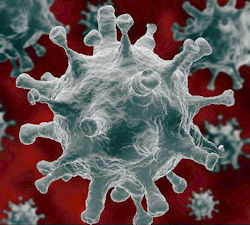Biological Agents
Severe Acute Respiratory Syndrome (SARS): SARs is a respiratory illness that’s caused by exposure to coronaviruses.
lt's due to a variety of factors, particularly a lack of immunity to the new virus. Here are some examples of coronaviruses:
- SARS-CoV, the virus that caused SARS, which was first identified in 2003
- MERS-CoV, the virus that caused Middle East respiratory syndrome (MERS), which was first identified in 2012
- SARS-CoV-2, the virus that causes COVID-19, which was first identified in 2019
Legionnaires' Disease: Legionnaires' disease is a bacterial disease commonly associated with water-based aerosols. It is often the result of poorly maintained air conditioning cooling towers and potable water systems.
Mold: Molds produce and release millions of spores small enough to be air-, water-, or insect-borne which may have negative effects on human health including allergic reactions, asthma, and other respiratory problems.
Plague: The World Health Organization reports 1,000 to 3,000 cases of plague every year. A bioterrorist release of plague could result in a rapid spread of the pneumonic form of the disease, which could have devastating consequences.
Ricin: Ricin is one of the most toxic and easily produced plant toxins. It has been used in the past as a bioterrorist weapon and remains a serious threat.
Tularemia: Tularemia is also known as "rabbit fever" or "deer fly fever" and is extremely infectious. Relatively few bacteria are required to cause the disease, which is why it is an attractive weapon for use in bioterrorism.
Viral Hemorrhagic Fevers (VHFs): Along with smallpox, anthrax, plague, botulism, and tularemia, hemorrhagic fever viruses are among the six agents identified by the Centers for Disease Control and Prevention (CDC) as the most likely to be used as biological weapons. Many VHFs can cause severe, life-threatening disease with high fatality rates.
Knowledge Check Choose the best answer for the question.
2-3. What is one of the most toxic and easily produced plant toxins that has been used as a bioterrorist weapon?
You forgot to answer the question!

